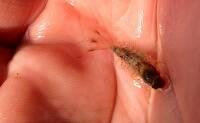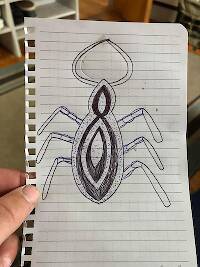
Blue-winged Olives
Baetis
Tiny Baetis mayflies are perhaps the most commonly encountered and imitated by anglers on all American trout streams due to their great abundance, widespread distribution, and trout-friendly emergence habits.
Featured on the forum

This specimen keys to the Epeorus albertae group of species. Of the five species in that group, the two known in Washington state are Epeorus albertae and Epeorus dulciana. Of the two, albertae has been collected in vastly more locations in Washington than dulciana, suggesting it is far more common. On that basis alone I'm tentatively putting this nymph in albertae, with the large caveat that there's no real information to rule out dulciana.

Troutnut is a project started in 2003 by salmonid ecologist Jason "Troutnut" Neuswanger to help anglers and
fly tyers unabashedly embrace the entomological side of the sport. Learn more about Troutnut or
support the project for an enhanced experience here.
PaulRoberts on May 4, 2012May 4th, 2012, 8:10 am EDT
This tiny little caddis larva was pumped from a small canyon stream brown trout stomach:

From the curled abdomen I was guessing it's Helicopsyche. Why is it out of its case? It looks too intact to have already had the case digested, although maybe the silk bound sand grains dissolve quickly. They shouldn't drift case-less as I believe they continue adding on the the same case. Anyway, thought I'd share it.
After looking at images of Helico, it doesn't look like it is. Too young to tell? It's tiny, like #28. Heck of a set of grippers eh? How about a very young Rhyacophilia -colors are right for it?

From the curled abdomen I was guessing it's Helicopsyche. Why is it out of its case? It looks too intact to have already had the case digested, although maybe the silk bound sand grains dissolve quickly. They shouldn't drift case-less as I believe they continue adding on the the same case. Anyway, thought I'd share it.
After looking at images of Helico, it doesn't look like it is. Too young to tell? It's tiny, like #28. Heck of a set of grippers eh? How about a very young Rhyacophilia -colors are right for it?
Creno on May 4, 2012May 4th, 2012, 1:41 pm EDT
I have never seen a green bodied Helicopsyche larva and legs don't look right. Do you think those black areas at apex of abdomen are large and sclerotized? If so, that is too many for Rhyacophila. Was it Bear Creek? lateinstar Leucotrichia?
PaulRoberts on May 4, 2012May 4th, 2012, 2:39 pm EDT
This is the only image I have. The end of the abdomen looks sclerotized to me. It was from Middle St Vrain canyon at about 6500ft -the trout from a seething pocket water pool. Late instar would seem timely wouldn't it? Leucotrichia? But the abdomen is not very wide.
Here's an image of a Leucotrichia:
http://www.dfg.ca.gov/abl/lab/CA_digital_ref_level1_Leucotrichia.asp
Here's an image of a Leucotrichia:
http://www.dfg.ca.gov/abl/lab/CA_digital_ref_level1_Leucotrichia.asp
Entoman on May 4, 2012May 4th, 2012, 8:41 pm EDT
I don't recognize any of the genera mentioned in this specimen. The size really throws me for a loop. Size 28? And the dorsal plates could go beyond the last two for all we can see...
"It's not that I find fishing so important, it's just that I find all other endeavors of Man equally unimportant... And not nearly as much fun!" Robert Traver, Anatomy of a Fisherman
Creno on May 5, 2012May 5th, 2012, 12:35 pm EDT
Sorry, by late instar I did not mean last instar. Should have said penultimate. And as Kurt implied - size already helps. Early instar caddis in general look quite different than the final instar. Early instar hydroptilids are no exception and have the typical, slightly tapered caddis abdomens rather than the enlarged abdomen. Very few figures/pictures are available in the NA literature. Do you have access to Hicken 1968? Wiggins 1996 has Leucotrichia.
In your specimen there looks like more than the single sclerotized apical plate typical of Rhyacophila. That led me to Leucotrichia, or a terrestrial larva like a beetle. If you don't have the specimen we will never know.
In your specimen there looks like more than the single sclerotized apical plate typical of Rhyacophila. That led me to Leucotrichia, or a terrestrial larva like a beetle. If you don't have the specimen we will never know.
PaulRoberts on May 5, 2012May 5th, 2012, 4:39 pm EDT
I don't have the specimen. Nor Hicken. It does look like there are more than a single apical plate. The size is what surprised me. Leuctrichia is probably best bet, but we'll never know I guess. Thanks for the responses guys.
Entoman on May 5, 2012May 5th, 2012, 11:57 pm EDT
The earlier instar would also explain the lack of case as well, Paul. As to what it is, I'm no closer than I was before and I wouldn't hazard a guess as to genus, but I do agree with Dave that it's probably a hydroptilid (Microcaddis) of some kind.
"It's not that I find fishing so important, it's just that I find all other endeavors of Man equally unimportant... And not nearly as much fun!" Robert Traver, Anatomy of a Fisherman
Entoman on May 6, 2012May 6th, 2012, 12:27 pm EDT
On second thought, Dave's genus suggestion is a good one. I forgot the other common genera (Hydroptila and Agraylea) like slower water.
"It's not that I find fishing so important, it's just that I find all other endeavors of Man equally unimportant... And not nearly as much fun!" Robert Traver, Anatomy of a Fisherman
Quick Reply
Related Discussions
Topic
Replies
Last Reply
2
Feb 15, 2013
by Troutnut
by Troutnut
Re: Identification of a possible Cordulegaster Dragonfly Nymph
In Cordulegaster Dragonfly Nymph by IanB
In Cordulegaster Dragonfly Nymph by IanB
6
Feb 10, 2017
by Taxon
by Taxon





